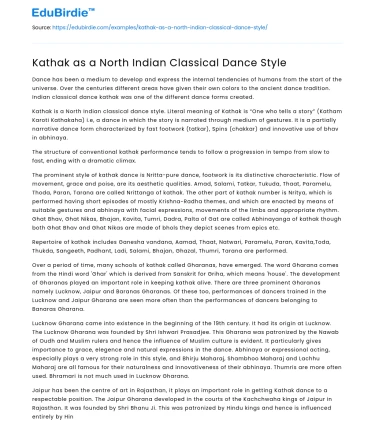Dance has been a medium to develop and express the internal tendencies of humans from the start of the universe. Over the centuries different areas have given their own colors to the ancient dance tradition. Indian classical dance kathak was one of the different dance forms created.
Kathak is a North Indian classical dance style. Literal meaning of Kathak is “One who tells a story” (Katham Karoti Kathakaha) i.e, a dance in which the story is narrated through medium of gestures. It is a partially narrative dance form characterized by fast footwork (tatkar), Spins (chakkar) and innovative use of bhav in abhinaya.
Save your time!
We can take care of your essay
- Proper editing and formatting
- Free revision, title page, and bibliography
- Flexible prices and money-back guarantee
The structure of conventional kathak performance tends to follow a progression in tempo from slow to fast, ending with a dramatic climax.
The prominent style of kathak dance is Nritta-pure dance, footwork is its distinctive characteristic. Flow of movement, grace and poise, are its aesthetic qualities. Amad, Salami, Tatkar, Tukuda, Thaat, Paramelu, Thoda, Paran, Tarana are called Nrittanga of kathak. The other part of kathak number is Nritya, which is performed having short episodes of mostly Krishna-Radha themes, and which are enacted by means of suitable gestures and abhinaya with facial expressions, movements of the limbs and appropriate rhythm. Ghat Bhav, Ghat Nikas, Bhajan, Kavita, Tumri, Dadra, Palta of Gat are called Abhinayanga of kathak though both Ghat Bhav and Ghat Nikas are made of bhols they depict scenes from epics etc.
Repertoire of kathak includes Ganesha vandana, Aamad, Thaat, Natwari, Paramelu, Paran, Kavita,Toda, Thukda, Sangeeth, Padhant, Ladi, Salami, Bhajan, Ghazal, Thumri, Tarana are performed.
Over a period of time, many schools of kathak called Gharanas, have emerged. The word Gharana comes from the Hindi word 'Ghar' which is derived from Sanskrit for Griha, which means 'house'. The development of Gharanas played an important role in keeping kathak alive. There are three prominent Gharanas namely Lucknow, Jaipur and Baranas Gharanas. Of these too, performances of dancers trained in the Lucknow and Jaipur Gharana are seen more often than the performances of dancers belonging to Banaras Gharana.
Lucknow Gharana came into existence in the beginning of the 19th century. It had its origin at Lucknow. The Lucknow Gharana was founded by Shri Ishwari Prasadjee. This Gharana was patronized by the Nawab of Oudh and Muslim rulers and hence the influence of Muslim culture is evident. It particularly gives importance to grace, elegence and natural expressions in the dance. Abhinaya or expressional acting, especially plays a very strong role in this style, and Bhirju Maharaj, Shambhoo Maharaj and Lachhu Maharaj are all famous for their naturalness and innovativeness of their abhinaya. Thumris are more often used. Bhramari is not much used in Lucknow Gharana.
Jaipur has been the centre of art in Rajasthan, it plays an important role in getting Kathak dance to a respectable position. The Jaipur Gharana developed in the courts of the Kachchwaha kings of Jaipur in Rajasthan. It was founded by Shri Bhanu Ji. This was patronized by Hindu kings and hence is influenced entirely by Hindu culture. The significance is given more on technical aspects of dance, such as complex and powerful footwork, multiple spins, and compositions in different talas. Presentation of Kavith is one of the unique qualities of Jaipur Gharana.
The Banaras Gharana was evolved at Banaras, founded by Shri Janki Prasad. This Gharana includes both the Tandava and Lasya and the influence of Hindu religion is evident. This Tandava dance characterizes this Gharana and hence the spirit of bravery is reflected in this style. Bhramari is more often used.






 Stuck on your essay?
Stuck on your essay?

